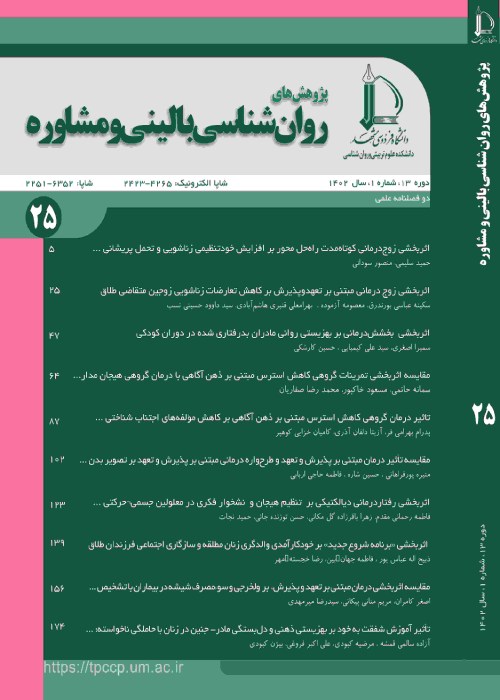Comparing the Effectiveness of Acceptance and Commitment Therapy and Schema Therapy based on Acceptance and Commitment on Body Image and Sexual Self-Esteem in Dialysis Women
Chronic renal failure is defined as the presence of at least three months of glomerular filtration rate less than 60 ml/min/1.73 m2 or structural/functional abnormalities of the kidney for more than three months (Lameire et al., 2021). Research showed that dialysis women suffer from a more negative body image than normal women (Dąbrowska-Bender et al., 2018). Body image is defined as individuals perception and attitudes towards their physical characteristics (Griffiths et al., 2018). Some studies have shown that body image dissatisfaction is directly related to a lack of self-confidence and self-esteem in sexual relations, more especially in women (Gillen & Markey, 2019). Sexual self-esteem is defined as individuals' overall desire to positively evaluate their capacity for participating in healthy sexual behaviors and experiences in a pleasurable and satisfying manner. Sexual self-esteem affects sexual behavior and includes emotional responses to thoughts and feelings (Akbari, 2017).Schema therapy and acceptance and commitment therapy are two different approaches, each of which looks at pathology with a different perspective. It seems that a combination of the two theraputic models can be a good complement to cover the shortcomings of each of them (Grecucci, 2018). Since no research has specifically compared the impacts of these approaches on psychological status of dialysis patients, it is important to investigate and compare the effectiveness of the acceptance and commitment therapy and schema therapy based on acceptance and commitment (AC-based schema therapy) on body image and sexual self-esteem of dialysis women.
This study was a semi-experimental research with a pretest-posttest and follow-up control group design. The statistical population consisted of all married dialysis women who referred to Khorasan Razavi Dialysis Patients Support Association between January 2021 and June 2022. The sample included 45 married women undergoing dialysis. The participants were selected using convenience sampling method and were randomly assigned to three groups. The first group (15 people) received the therapeutic intervention based on acceptance and commitment, the second group (15 people) received the AC-based schema therapy intervention, and the third group (15 people) were placed on the waiting list to receive psychological treatment. The tools included the Body Image Concern Inventory (BICI) and Sexual Self-Esteem Index for Woman-Short Form (SSEI-W-SF). The AC-based therapy sessions were held based on the treatment protocol of Gustafson (2020) during ten 120-minute weekly sessions. The AC-based schema therapy sessions were held according to the treatment protocol of McKay et al. (2012) for ten 120-minute weekly sessions. The data were analyzed using repeated measures analysis of variance and Bonferroni test.
The results of chi-square test demonstrated that the groups were homogeneous in terms of age (p=0.979, χ2=8.00), duration of marriage (p=1.000, χ2=5.267), and duration of dialysis (p=0.628, χ2=9.867). After checking that the assumptions were fulfilled, repeated measures analysis of variance was used. The results showed that body image scores in the within-group section (P=0.001, F=57.908), the interaction effect of group and repetition (P=0.001, F=23.243) and the between-group effect (P=0.035, F=3.640) are significant in the studied groups in three phases of measurement. Moreover, sexual self-esteem scores in the within-group section (P=0.001, F=25.429), the interaction effect of group and repetition (P=0.001, F=6.575), and the between-group effect (P=0.037, F=3.251) are significant in the studied groups in three phases of measurement (P<0.05). Considering the significance of F statistic, it seems necessary to make post-experience comparisons. Hence, Bonferroni post hoc test was used to compare the therapy groups with the control group.The results of Bonferroni post hoc test revealed that in the posttest and follow-up phases, there is no significant difference between the studied groups (AC-based therapy and AC-based schema therapy and the control group) in the variables of body image (P=0.98) and sexual self-esteem (P=0.85), but in the posttest and follow-up phases, a significant difference was found between the AC-based therapy group and AC-based schema therapy with the control group (P<0.05). AC-based schema therapy caused more changes in the components of body image and sexual self-esteem in dialysis women.
The results indicating the greater impact of AC-based schema therapy compared to acceptance and commitment therapy are consistent with the findings of Aalami (2020). Paying special attention to the factors causing ineffective behaviors adopted in order to reduce the emotional pain of the schema is one of the strengths of AC-based schema therapy compared to acceptance and commitment therapy (Nikpour, 2021). Showing the difficult situation of frequent dialysis as the only factor provoking uncomfortable feelings and thoughts formed from childhood experiences causes patients to know the root of their problems instead of considering the disease as the cause of dissatisfaction with appearance and lack of self-esteem in sexual relations. As a result, it will make them more motivated and hopeful to overcome and adjust their maladaptive schemas. The other strength of AC-based schema therapy compared to acceptance and commitment therapy is that clients more easily identify their values that are beyond their maladaptive schemas, and as a result, are more motivated to follow values (McKay, 2012). Another advantage of AC-based schema therapy is dedicating some of the group therapy sessions to teach communication skills, including self-expression, overcoming feelings of anger and hatred, assertiveness and marital skills (Lev & McKay, 2017), which increases intimacy and emotional interest of women in the marital relationship. Learning these skills, in addition to providing the apportunity for experiencing more sexual pleasure and the desire to have sexual relationships, can prevent the recurrence of dialysis women’s problems, since better satisfaction of the unsatisfied basic needs make people able to prevent the activation of maladaptive schemas.
- حق عضویت دریافتی صرف حمایت از نشریات عضو و نگهداری، تکمیل و توسعه مگیران میشود.
- پرداخت حق اشتراک و دانلود مقالات اجازه بازنشر آن در سایر رسانههای چاپی و دیجیتال را به کاربر نمیدهد.


